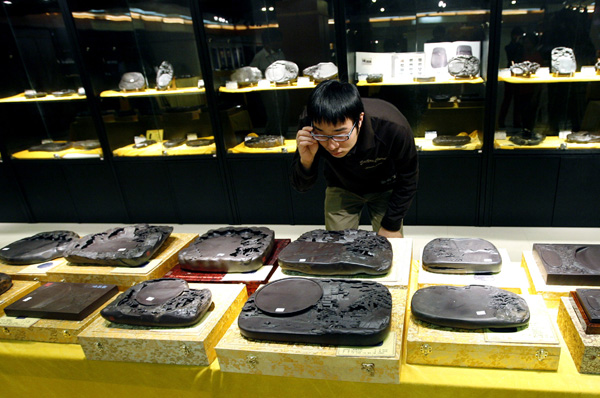 |
|
Inkstones[Photo by Xinhua]
|
A cake of ink is ground against the surface of the inkstone and water is applied gradually. After ink gathers in one end of the stone, the brush is dipped into the well and can be used to write. The intensity of the ink depends on the percentage of water used as well as the dryness of the brush.
Dating back 3,000 years, a stone mortar for grinding ink is what Chinese people traditionally used to write and paint. Inkstones are seen not just as an instrument to hold ink, but also as something that allows an artist or calligrapher to collect their thoughts and concentrate before putting brush to paper.
In ancient times, writing was taken very seriously.
“An inkstone for a refined Chinese scholar or artist is like a farm to a peasant. The scholar or artist ploughs with his brushes and plants his emotions, hopes and ambitions onto paper,” Han Huizhi tells Shanghai Daily.
Han, 38, is the curator of Han Tianheng Art Museum in Shanghai’s suburban Jiading District, which includes many rare antique inkstones, paintings, seals and more.
“In ancient times, people usually had deep feelings toward inkstones,” Han adds.
Huang Tingjian, an artist and poet from the Song Dynasty (960-1127), was so enthralled with inkstones that he traveled to remote mountains searching for the best material (stone) to make them.
“There was no transportation and no roads. I walked through clouds and mist step by step to reach the mountains,” Huang wrote about his experience.
A top inkstone has a refined and smooth surface with elaborate natural patterns. It is thick and solid and can be kept for a long time. Since ink dries quickly, a good inkstone can store water, preventing the ink from drying.
Ma Weidu, one of China’s most famous collectors and a connoisseur of Chinese antiques, says: “In ancient times, one way to test the quality of an inkstone was to put your warm hands on the surface of a cold inkstone in the winter. The temperature difference produces moisture. If the inkstone was still steamed up after removing your hands, it was a good-quality inkstone.”
